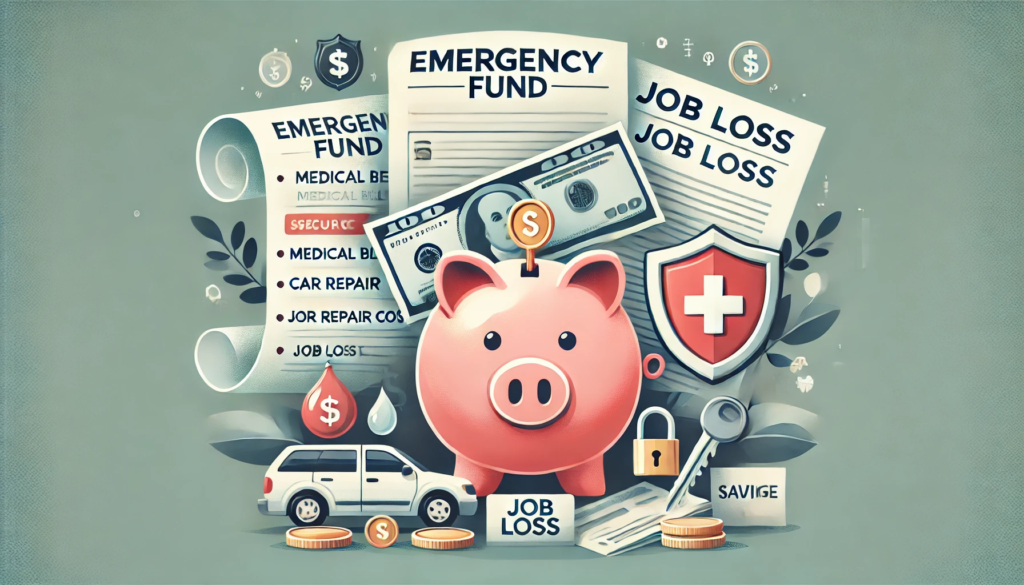Key Takeaways
- Financial Security: An emergency fund ensures you’re prepared for unexpected events like job loss, medical emergencies, or urgent repairs, preventing financial instability.
- Debt Prevention: By having a savings buffer, you can avoid relying on high-interest loans or credit cards during emergencies, protecting your long-term financial health.
- Peace of Mind: An emergency fund reduces stress and gives you the confidence to face life’s uncertainties, knowing you’re financially prepared for any situation.
In an ever-changing world where financial uncertainties are a constant, the importance of having a safety net cannot be overstated.
Imagine facing an unexpected job loss, a sudden medical emergency, or an urgent home repair without the financial cushion to weather the storm.
Such situations can not only drain your savings but also plunge you into debt, creating long-term financial setbacks.
This is where an emergency fund plays a pivotal role in ensuring financial stability and peace of mind.

An emergency fund is more than just a savings account; it’s a financial lifeline designed to protect you during life’s unpredictable moments.
Whether you’re a seasoned financial planner or someone just starting to think about managing money wisely, building and maintaining an emergency fund is one of the most critical steps toward achieving overall financial security.
It serves as a buffer against the unexpected, allowing you to handle emergencies without disrupting your long-term financial goals or dipping into investments.
In this complete guide, we’ll explore why an emergency fund is so important, how it can safeguard your financial health, and the practical steps to build one effectively.
From understanding the concept of an emergency fund to learning how to avoid common pitfalls, this guide is designed to equip you with the knowledge and tools needed to take control of your finances.
By the end of this article, you’ll not only understand the necessity of an emergency fund but also feel empowered to start or enhance your own.
Whether you’re preparing for personal emergencies or safeguarding against broader economic uncertainties, having a well-structured emergency fund can make all the difference.
So, let’s dive in and explore why this essential financial tool should be a cornerstone of your money management strategy.
Before we venture further into this article, we would like to share who we are and what we do.
About 9cv9
9cv9 is a business tech startup based in Singapore and Asia, with a strong presence all over the world.
With over nine years of startup and business experience, and being highly involved in connecting with thousands of companies and startups, the 9cv9 team has listed some important learning points in this overview of Why is an Emergency Fund So Important.
If your company needs recruitment and headhunting services to hire top-quality employees, you can use 9cv9 headhunting and recruitment services to hire top talents and candidates. Find out more here, or send over an email to [email protected].
Or just post 1 free job posting here at 9cv9 Hiring Portal in under 10 minutes.
Why is an Emergency Fund So Important? A Complete Guide
- What is an Emergency Fund?
- Why is an Emergency Fund So Important?
- How to Build an Emergency Fund
- Common Mistakes to Avoid
- Benefits of Having an Emergency Fund
1. What is an Emergency Fund?
An emergency fund is a dedicated financial reserve designed to cover unexpected expenses or financial emergencies. Unlike regular savings or investment accounts, it serves a specific purpose: to act as a safety net when unforeseen circumstances arise. Below is a detailed breakdown of what an emergency fund is and how it works, supported by examples to highlight its importance.
Definition and Purpose of an Emergency Fund
- Dedicated Savings: An emergency fund is a separate reserve of money set aside specifically for unexpected events.
- Purpose: Provides immediate financial support during emergencies, reducing reliance on debt or high-interest loans.
- Safety Net: Acts as a financial buffer, preventing disruptions to long-term goals like retirement savings or investments.
Examples:
- Covering medical bills for an unexpected illness or injury.
- Paying for urgent home repairs, such as fixing a leaking roof or replacing a broken water heater.
- Managing expenses during a sudden job loss, ensuring you can pay for rent, utilities, and groceries.
How an Emergency Fund Differs from Regular Savings
- Specific Purpose: Unlike general savings, which might be used for vacations or large purchases, an emergency fund is exclusively for unforeseen expenses.
- Accessibility: Kept in a highly liquid form (e.g., savings accounts) to allow quick access during emergencies.
- No Risk of Loss: Unlike investments, an emergency fund is not subject to market fluctuations or risks.
Examples:
- Savings for a planned vacation cannot substitute for an emergency fund. If an urgent car repair arises, an emergency fund ensures you don’t dip into vacation savings or borrow money.
Common Emergencies Covered by an Emergency Fund
- Medical Expenses:
- Uninsured or unexpected medical treatments.
- Emergency dental procedures.
- Job Loss or Income Reduction:
- Temporary coverage for rent, bills, and daily expenses.
- Helps bridge the gap while finding new employment.
- Unexpected Repairs:
- Vehicle breakdowns requiring immediate fixes.
- Major home repairs, such as HVAC system replacement.
- Family Emergencies:
- Sudden travel to assist a family member in crisis.
- Support during unexpected events like funeral expenses.
Real-Life Example:
Imagine losing your job unexpectedly. Without an emergency fund, you might rely on credit cards or personal loans, incurring high interest rates. However, a well-funded emergency account can cover your living expenses for several months, reducing financial stress.
Key Characteristics of an Emergency Fund
- Liquidity:
- Money is easily accessible.
- Typically stored in high-yield savings accounts, money market accounts, or similar low-risk vehicles.
- Adequate Size:
- Should ideally cover 3–6 months of living expenses.
- For those in unstable industries, 6–12 months might be more appropriate.
- Segregation:
- Kept separate from regular savings or checking accounts to avoid unintentional spending.
Practical Tip:
Open a dedicated high-yield savings account for your emergency fund. This ensures you earn some interest while keeping the money accessible.
Why Everyone Needs an Emergency Fund
- Prevents Financial Ruin: Unexpected expenses can lead to high debt, strained relationships, and even bankruptcy without an emergency fund.
- Ensures Financial Independence: Reduces reliance on loans, family, or friends during tough times.
- Provides Peace of Mind: Knowing you’re prepared for life’s surprises boosts confidence and reduces stress.
Case Study:
A young professional saved three months’ worth of expenses in an emergency fund. When the COVID-19 pandemic caused her workplace to shut down, she used her emergency fund to cover rent, groceries, and medical bills until she secured another job, avoiding debt or financial hardship.
By understanding what an emergency fund is and its critical role in financial stability, you can start building your own safety net to prepare for life’s unpredictable challenges. This dedicated financial reserve not only provides immediate relief during emergencies but also safeguards your long-term financial goals.
2. Why is an Emergency Fund So Important?
An emergency fund is an essential financial tool that offers security, stability, and peace of mind during life’s unpredictable moments. It serves as a financial safety net, protecting individuals and families from falling into debt or derailing their long-term financial goals. Below is an in-depth exploration of why an emergency fund is so crucial, divided into key sub-sections for clarity and supported by practical examples.
Financial Stability During Emergencies
Immediate Access to Funds
- Covers Unexpected Expenses:
- Medical emergencies, urgent home repairs, or sudden travel needs.
- Example: Paying for a broken furnace during winter without relying on credit cards.
- Avoids High-Interest Debt:
- Eliminates the need to take out personal loans or use high-interest credit cards.
- Example: Using an emergency fund to fix a car instead of borrowing money at a 15% interest rate.
Prevents Financial Ruin
- Protects Essential Expenses:
- Ensures you can pay for rent, utilities, and groceries even during tough times.
- Example: A laid-off employee uses their emergency fund to cover living costs while job hunting.
- Reduces Risk of Bankruptcy:
- Keeps you from exhausting all financial resources or defaulting on obligations.
Provides Peace of Mind
Reduces Stress and Anxiety
- Financial Confidence:
- Knowing you have a safety net creates emotional and mental peace.
- Example: Parents with an emergency fund are less worried about unexpected medical bills for their children.
- Improved Decision-Making:
- Allows for thoughtful decisions instead of hasty actions driven by financial panic.
Enhances Life Quality
- Encourages Long-Term Planning:
- Frees you to focus on future goals like buying a home or retirement.
- Example: A young couple, secure in their emergency fund, confidently starts saving for a down payment on their first house.
Protects Long-Term Financial Goals
Avoids Disrupting Investments
- Keeps Investments Intact:
- Prevents the need to liquidate stocks, bonds, or retirement accounts prematurely.
- Example: Instead of withdrawing from a 401(k) with penalties, an emergency fund is used to cover unexpected medical expenses.
- Ensures Compounding Benefits:
- Leaves your long-term savings and investments untouched, allowing them to grow over time.
Safeguards Future Plans
- Prevents Derailment:
- Allows you to continue funding goals like education, travel, or major purchases.
- Example: A student uses an emergency fund to handle a laptop repair, ensuring their tuition savings remain unaffected.
Helps Navigate Economic Uncertainty
During Recessions or Downturns
- Job Security Concerns:
- Offers financial coverage in industries prone to layoffs.
- Example: During the COVID-19 pandemic, millions relied on emergency funds to weather prolonged unemployment.
- Mitigates Inflationary Pressures:
- Supports day-to-day living during periods of high inflation.
Strengthens Resilience
- Creates Flexibility:
- Allows you to adapt to changing circumstances without financial strain.
- Example: A freelancer with inconsistent income uses an emergency fund during lean months.
- Promotes Economic Stability:
- Reduces reliance on government aid or community support during personal crises.
Avoiding Common Financial Pitfalls
Minimizes Debt Accumulation
- Avoids Payday Loans:
- Emergency funds eliminate the need for high-interest, short-term loans.
- Example: A single parent uses their fund to replace a broken appliance instead of taking out a payday loan at 20% interest.
- Prevents Overreliance on Credit:
- Helps you maintain good credit by paying bills on time, even during financial stress.
Maintains Financial Independence
- Reduces Dependence on Others:
- Avoids borrowing money from family or friends.
- Example: A young professional handles unexpected dental surgery expenses independently through their emergency fund.
- Empowers Decision-Making:
- Grants freedom to make life choices, such as switching jobs or moving cities, without financial fear.
Real-Life Impact of an Emergency Fund
Case Study: Job Loss Recovery
- A marketing professional loses their job unexpectedly but has six months of expenses saved in an emergency fund. This allows them to focus on finding a suitable role without taking a lower-paying job out of desperation.
Case Study: Medical Emergency
- A family uses their emergency fund to cover out-of-pocket costs for an urgent surgery. This prevents them from using credit cards or liquidating a college savings account.
Conclusion
An emergency fund is more than a financial reserve; it’s a lifeline that provides stability, confidence, and protection against life’s uncertainties. By having one in place, you can navigate emergencies with ease, safeguard your long-term goals, and enjoy greater financial freedom and independence.
3. How to Build an Emergency Fund
Building an emergency fund is a crucial step toward achieving financial security. While it may seem challenging, a strategic and consistent approach can help you establish this vital safety net. This guide breaks down the steps into manageable sub-sections, offering practical tips and relevant examples to help you get started and stay on track.
Determine Your Emergency Fund Goal
Assess Your Monthly Expenses
- List Essential Costs:
- Include rent/mortgage, utilities, groceries, transportation, insurance, and minimum debt payments.
- Example: A young professional calculates monthly expenses at $2,500, setting an initial target of $7,500 for a three-month fund.
- Exclude Non-Essentials:
- Entertainment, dining out, and subscriptions can be excluded for this calculation.
Set a Realistic Goal
- Three to Six Months of Expenses:
- Most financial experts recommend saving enough to cover 3–6 months of essential expenses.
- Example: A freelancer with an irregular income targets a six-month reserve to account for potential gaps in earnings.
- Tailor to Your Situation:
- Single individuals with stable jobs may opt for three months, while families or those in high-risk jobs might aim for a larger fund.
Create a Savings Plan
Break Down Your Goal
- Divide into Smaller Milestones:
- Start with $1,000 as a short-term goal before scaling up to three months of expenses.
- Example: A student sets an initial goal of $500 and increases it to $1,500 as their income grows.
- Set Monthly Targets:
- Allocate a fixed percentage of income, such as 10%, to your emergency fund.
Automate Your Savings
- Set Up Direct Transfers:
- Automate transfers from your checking account to a dedicated savings account.
- Example: A teacher schedules a $200 monthly transfer to a high-yield savings account.
- Use Savings Apps:
- Apps like Digit or Acorns can round up purchases and save the difference.
Cut Expenses and Boost Savings
Reduce Non-Essential Spending
- Identify Areas to Cut Back:
- Limit dining out, cancel unused subscriptions, or shop for discounts.
- Example: A couple saves $100 monthly by cooking meals at home instead of dining out.
- Use Cashback and Discounts:
- Shop with cashback apps or take advantage of sales to save money for your fund.
Increase Your Income
- Pursue Side Hustles:
- Freelancing, tutoring, or selling handmade crafts can generate extra cash.
- Example: A graphic designer takes up weekend gigs and earns $500 monthly for their emergency fund.
- Monetize Unused Assets:
- Rent out unused rooms, sell old electronics, or declutter your home.
Choose the Right Savings Account
Opt for Liquidity
- High-Yield Savings Accounts:
- Offers easy access and higher interest rates compared to regular accounts.
- Example: A nurse opens a high-yield savings account that earns 3% annual interest.
- Money Market Accounts:
- Combine the benefits of savings and checking accounts, providing flexibility and moderate returns.
Keep It Separate
- Dedicated Account:
- Avoid mixing your emergency fund with everyday savings to prevent accidental spending.
- Example: A software developer uses a separate account solely for their emergency fund.
Stay Consistent and Adaptable
Regularly Review Your Progress
- Track Your Savings:
- Use budgeting tools or spreadsheets to monitor contributions and growth.
- Example: A family checks their fund’s progress quarterly to stay motivated.
- Adjust for Inflation and Life Changes:
- Increase your goal if expenses rise due to inflation or major life changes like marriage or children.
Avoid Using the Fund Unnecessarily
- Reserve for True Emergencies:
- Only dip into the fund for critical, unexpected expenses.
- Example: An entrepreneur avoids using their emergency fund for a vacation, reserving it for unforeseen business challenges.
Build Slowly but Steadily
Start Small
- Begin with Spare Change:
- Save loose change or small amounts regularly to build momentum.
- Example: A college student deposits $20 weekly, accumulating $1,040 annually.
- Celebrate Milestones:
- Reward yourself modestly when you reach significant savings milestones.
Make Adjustments When Needed
- Reassess During Financial Setbacks:
- Reduce your savings rate temporarily if faced with financial constraints.
- Example: A worker on reduced hours saves 5% of their income until they return to full-time work.
Real-Life Example of Emergency Fund Success
- Scenario:
- A family with a $10,000 emergency fund uses it to cover medical expenses after an unexpected surgery. This prevents them from accruing $10,000 in credit card debt with a 20% interest rate.
Building an emergency fund requires discipline, planning, and consistency, but the rewards far outweigh the effort. By following these steps, you can establish a robust financial safety net, ensuring peace of mind and stability during life’s unexpected challenges.
4. Common Mistakes to Avoid
Building an emergency fund is a critical step toward financial security, but several common pitfalls can hinder your progress or render your efforts ineffective. Understanding these mistakes and knowing how to avoid them can help you establish a robust and reliable emergency fund. This section delves into the most frequent errors individuals make when creating and managing their emergency funds, supported by relevant examples to illustrate each point.
Overestimating or Underestimating the Required Fund Size
Accurately determining the appropriate size of your emergency fund is essential for its effectiveness. Misjudging this amount can lead to financial strain or unnecessary savings.
Overestimating the Fund Size
- Excessive Savings: Allocating more money than necessary can divert funds from other important financial goals like investments or retirement.
- Example: Saving six months’ worth of expenses when three months would suffice for your stable job and low-risk industry.
- Opportunity Cost: Missing out on potential investment gains by keeping too much money in low-interest savings accounts.
- Example: Keeping $20,000 in an emergency fund instead of investing $10,000 and using the remaining $10,000 for a well-sized fund.
Underestimating the Fund Size
- Insufficient Coverage: Not saving enough to cover several months of expenses can leave you vulnerable during prolonged emergencies.
- Example: Saving only one month’s expenses and facing a six-month unemployment period, forcing you to use credit cards or loans.
- Frequent Fund Depletion: Regularly dipping into the fund without replenishing it due to inadequate savings.
- Example: An individual saves $2,000 instead of $6,000 and exhausts the fund quickly when faced with multiple emergencies.
Using the Emergency Fund for Non-Essential Purchases
Misusing the emergency fund for planned or discretionary expenses undermines its purpose and can leave you unprotected during genuine emergencies.
Common Non-Essential Uses
- Vacations and Travel: Spending emergency savings on trips instead of reserving it for unexpected events.
- Example: Using $1,500 from the emergency fund to pay for a family vacation, leaving the fund insufficient for medical emergencies.
- Luxury Items: Purchasing high-end gadgets, designer clothes, or other luxury items with emergency savings.
- Example: Buying a new smartphone with $800 from your emergency fund rather than saving for genuine needs.
Psychological Triggers
- Impulse Spending: Succumbing to impulsive purchases when tempted by sales or promotions.
- Example: Seeing a limited-time discount on a high-priced appliance and using emergency funds to buy it impulsively.
- Peer Pressure: Feeling the need to keep up with friends or family by spending from your emergency fund.
- Example: Using your savings to host parties or social gatherings to maintain social status.
Failing to Replenish the Fund After Use
Depleting your emergency fund without replenishing it leaves you vulnerable to future emergencies, undermining your financial stability.
Consequences of Not Replenishing
- Vulnerability to Future Crises: Without rebuilding the fund, you’re exposed to financial strain during subsequent emergencies.
- Example: Using the entire emergency fund for a car repair and not saving again, making you reliant on credit for the next unexpected expense.
- Increased Debt: Continuously using and not refilling the fund may force you to accumulate debt.
- Example: Using the fund for multiple emergencies without replenishing leads to taking out high-interest loans for new issues.
Strategies to Replenish
- Prioritize Rebuilding: Make rebuilding the emergency fund a top financial priority after using it.
- Example: Allocating 20% of your monthly income toward replenishing the fund until it reaches the target amount.
- Automate Savings: Set up automatic transfers to ensure consistent contributions towards rebuilding.
- Example: Scheduling a monthly transfer of $300 to your emergency fund until it’s fully replenished.
Lack of Regular Reviews and Adjustments
Failing to periodically assess and adjust your emergency fund can result in an inadequate or excessive savings pool, depending on life changes and economic conditions.
Importance of Regular Reviews
- Adjust for Inflation: Rising costs of living mean your initial savings goal may become insufficient over time.
- Example: Increasing your emergency fund from $10,000 to $12,000 to account for a 20% rise in living expenses due to inflation.
- Life Changes: Major life events such as marriage, having children, or buying a home can impact your financial needs.
- Example: Expanding your emergency fund after having a child to cover additional medical and childcare expenses.
How to Conduct Reviews
- Annual Assessment: Review your emergency fund annually to ensure it aligns with current financial goals and circumstances.
- Example: During tax season, evaluate your savings and adjust your contributions based on any financial changes.
- Milestone Check-ins: Assess the fund after significant life events or changes in employment status.
- Example: After a promotion or salary increase, reassess and potentially increase your emergency fund contributions.
Not Keeping the Fund Easily Accessible
Storing your emergency fund in accounts that are difficult to access or have high penalties can delay access during critical times.
Choosing the Right Accounts
- Low Liquidity Accounts: Keeping funds in long-term investments or accounts with withdrawal penalties restricts access when needed.
- Example: Storing emergency funds in a certificate of deposit (CD) with a 6-month lock-in period.
- Unconventional Storage: Using non-traditional methods like cash at home can pose risks of loss or theft.
- Example: Keeping large amounts of cash in a home safe instead of a secure bank account.
Best Practices for Accessibility
- High-Yield Savings Accounts: Opt for accounts that offer good interest rates while allowing easy access to funds.
- Example: Maintaining your emergency fund in an online high-yield savings account with no withdrawal limits.
- Multiple Accounts: Consider splitting your emergency fund across different accounts to ensure accessibility.
- Example: Keeping part of the fund in a savings account and another part in a money market account for flexibility.
Ignoring Automatic Savings Options
Manually saving for an emergency fund can lead to inconsistency and lower savings rates. Ignoring automated savings tools can impede your progress.
Benefits of Automation
- Consistency: Automatic transfers ensure regular contributions without requiring manual intervention.
- Example: Setting up a bi-weekly transfer of $150 from your checking to your emergency fund savings account.
- Discipline: Reduces the temptation to spend the money elsewhere.
- Example: Automating 10% of each paycheck to go directly into your emergency fund, making saving a priority.
Common Oversights
- Forgetting to Set Up Automation: Relying solely on manual savings can result in missed contributions.
- Example: Starting to save manually but skipping transfers due to forgetfulness or lack of time.
- Not Adjusting Automated Amounts: Failing to increase automated contributions as income grows can slow fund growth.
- Example: Maintaining the same automated transfer amount despite receiving a raise, thus not accelerating the savings process.
Neglecting to Prioritize the Emergency Fund
Treating the emergency fund as a secondary financial goal can delay its establishment and reduce its effectiveness.
Common Reasons for Neglect
- Competing Financial Goals: Focusing on other objectives like paying off debt or saving for a vacation instead of prioritizing the emergency fund.
- Example: Allocating all extra income to a vacation fund while the emergency fund remains underfunded.
- Lack of Awareness: Underestimating the importance of an emergency fund in overall financial planning.
- Example: Believing that insurance alone can cover all unexpected expenses without the need for personal savings.
Strategies to Prioritize
- Financial Planning: Integrate the emergency fund into your overall financial plan as a top priority.
- Example: Allocating 15% of your monthly budget specifically for building the emergency fund before other savings or investments.
- Set Clear Goals: Define specific milestones for your emergency fund to maintain focus and motivation.
- Example: Setting incremental goals like $1,000, $3,000, and then $6,000 to systematically build your fund.
Relying Solely on Employer Benefits
Depending entirely on employer-provided benefits, such as unemployment insurance or health coverage, can leave gaps in your financial protection.
Limitations of Employer Benefits
- Coverage Gaps: Employer benefits may not cover all expenses or may have limitations and waiting periods.
- Example: Unemployment benefits might only cover 50% of your salary for three months, insufficient for longer job searches.
- Dependency on Employment: Losing your job can result in losing access to certain benefits.
- Example: Health insurance benefits tied to employment may terminate upon job loss, requiring immediate alternative coverage.
Importance of Personal Savings
- Comprehensive Coverage: Personal emergency funds can cover a broader range of expenses beyond what employer benefits offer.
- Example: Using your emergency fund to pay for health insurance premiums after losing job-based coverage.
- Financial Autonomy: Relying on your savings provides greater control and security during emergencies.
- Example: Choosing to take a career break or pursue further education without financial stress, supported by your emergency fund.
Ignoring Inflation and Cost of Living Increases
Failing to account for inflation and rising living costs can render your emergency fund inadequate over time.
Impact of Inflation
- Reduced Purchasing Power: Inflation decreases the real value of your savings, making your emergency fund less effective.
- Example: A $10,000 emergency fund may only cover $9,000 worth of expenses after a 10% inflation rate.
- Rising Expenses: As the cost of living increases, your initial savings goal may no longer suffice.
- Example: Monthly expenses grow from $2,000 to $2,500 due to inflation, requiring a larger emergency fund.
Mitigating Inflation Effects
- Regular Contributions: Continuously add to your emergency fund to keep pace with inflation.
- Example: Increasing your monthly emergency fund contribution by 2% each year to match inflation rates.
- Investment Strategies: Consider placing a portion of the fund in inflation-protected securities while maintaining liquidity.
- Example: Allocating 20% of the emergency fund to Treasury Inflation-Protected Securities (TIPS) to preserve purchasing power.
Failing to Communicate Fund Usage Guidelines
Lack of clear rules on when and how to use the emergency fund can lead to misuse or depletion during non-emergencies.
Importance of Clear Guidelines
- Discipline: Establishing rules helps maintain the fund’s integrity and ensures it’s used appropriately.
- Example: Creating a list of qualifying emergencies, such as medical emergencies, job loss, or major home repairs, and adhering to it.
- Accountability: Sharing guidelines with family members prevents unauthorized or unnecessary use.
- Example: Discussing with your partner that the emergency fund is only for critical expenses, avoiding unilateral spending decisions.
Establishing Usage Policies
- Define Emergencies: Clearly outline what constitutes an emergency to prevent ambiguity.
- Example: Specifying that emergencies include natural disasters, serious illnesses, or sudden loss of income.
- Approval Process: Implement a process for accessing the fund, such as requiring a second opinion or documentation.
- Example: Agreeing that any withdrawal from the emergency fund must be reviewed and approved by both partners in a household.
Ignoring Tax Implications
Overlooking the tax considerations of how and where you store your emergency fund can affect your savings’ efficiency and accessibility.
Tax-Advantaged Accounts
- High-Yield Savings Accounts: Typically, interest earned is subject to income tax, reducing net gains.
- Example: Earning interest on your emergency fund but paying taxes on the earnings, slightly diminishing the growth.
- Avoid Tax Penalties: Ensure the fund is kept in accounts without early withdrawal penalties.
- Example: Not placing the fund in a Certificate of Deposit (CD) that imposes penalties for early withdrawals.
Tax-Efficient Strategies
- Use Taxable Accounts: Maintain the emergency fund in a standard savings account to avoid penalties and ensure tax simplicity.
- Example: Keeping the emergency fund in an online savings account with no withdrawal fees and manageable interest rates.
- Consider Roth IRAs: Some individuals use Roth IRAs as a backup emergency fund, though this comes with restrictions and potential penalties.
- Example: Withdrawing contributions (not earnings) from a Roth IRA without penalties in an emergency, while maintaining separate savings for other needs.
Not Considering Household vs. Individual Needs
Failing to tailor the emergency fund to the specific needs of your household or individual circumstances can lead to inadequate savings.
Household Considerations
- Multiple Income Streams: Households with more than one income may need to adjust the fund size based on the loss of multiple incomes.
- Example: A dual-income family might require a larger emergency fund to cover expenses if both partners lose their jobs simultaneously.
- Dependents and Responsibilities: Families with children or dependents may have higher and more varied expenses.
- Example: A single parent with dependents may need a larger fund to cover childcare, education, and medical expenses.
Individual Considerations
- Personal Health and Lifestyle: Individuals with specific health needs or lifestyles may require a tailored emergency fund.
- Example: Someone with chronic health conditions may need additional funds to cover ongoing medical expenses.
- Career Stability: Freelancers or those in volatile industries might need a larger emergency fund to account for irregular income.
- Example: A freelance writer saves a six-month fund due to the unpredictability of contract-based work.
Relying on Credit Instead of Savings
Choosing to use credit options instead of relying on your emergency fund can lead to unnecessary debt and financial strain.
Drawbacks of Using Credit
- High-Interest Rates: Credit cards and loans often come with high-interest rates, increasing the cost of emergencies.
- Example: Using a credit card with a 20% APR to pay for an unexpected car repair, resulting in substantial interest payments.
- Debt Accumulation: Relying on credit can lead to long-term debt, impacting credit scores and financial health.
- Example: Accumulating credit card debt during multiple emergencies without the ability to repay, leading to a lower credit score.
Advantages of Using Savings
- Cost Savings: Using your emergency fund avoids interest payments and keeps your debt levels manageable.
- Example: Paying for an unexpected medical procedure from your emergency fund instead of taking out a personal loan.
- Financial Freedom: Maintaining low or no debt enhances your financial stability and independence.
- Example: Staying debt-free by using savings for emergencies, allowing you to allocate funds toward other financial goals.
Ignoring the Emotional Aspect of Saving
Overlooking the psychological factors involved in saving can impede your ability to build and maintain an emergency fund.
Emotional Barriers
- Fear of Not Having Enough: Anxiety about future uncertainties can either paralyze saving efforts or lead to panic spending.
- Example: Feeling overwhelmed by the idea of saving a large amount and avoiding saving altogether.
- Instant Gratification: Preferring immediate rewards over long-term security can result in prioritizing short-term pleasures over saving.
- Example: Choosing to spend extra income on entertainment rather than saving it for emergencies.
Overcoming Emotional Barriers
- Set Clear Goals: Define specific, achievable milestones to maintain motivation and a sense of accomplishment.
- Example: Setting a goal to save $1,000 initially, then gradually increasing the target as you achieve each milestone.
- Visual Reminders: Use visual aids like charts or apps to track progress and stay motivated.
- Example: Creating a progress chart that visually displays the growth of your emergency fund over time.
Not Including All Potential Expenses
Failing to account for all possible emergencies can leave your fund insufficient when confronted with diverse financial challenges.
Comprehensive Expense Planning
- Broad Coverage: Ensure the fund can cover a wide range of emergencies, from medical expenses to natural disasters.
- Example: Including potential costs for pet emergencies, major appliance breakdowns, or unexpected travel due to family crises.
- Hidden Costs: Consider indirect expenses that may arise during an emergency, such as lost income or additional living costs.
- Example: Factoring in temporary accommodation costs if your home becomes uninhabitable due to a natural disaster.
Detailed Budgeting
- Thorough Expense Listing: Create a comprehensive list of all possible essential expenses to determine the appropriate fund size.
- Example: Listing monthly bills, debt payments, groceries, transportation, insurance, and any other recurring essential costs.
- Scenario Planning: Anticipate different types of emergencies and estimate their potential costs.
- Example: Estimating the cost of a three-month rent payment in case of job loss or the average expense for unexpected medical treatments.
Lack of Financial Education
Insufficient understanding of financial principles can lead to ineffective management of the emergency fund.
Importance of Financial Literacy
- Informed Decisions: Understanding how to properly save, invest, and manage your emergency fund ensures it serves its intended purpose.
- Example: Knowing the difference between high-yield savings accounts and regular savings accounts to maximize interest earnings.
- Avoiding Pitfalls: Being aware of common financial mistakes helps in preventing errors that could compromise your fund.
- Example: Understanding the risks of placing your emergency fund in high-risk investments that could lose value during emergencies.
Enhancing Financial Knowledge
- Educational Resources: Utilize books, online courses, and financial blogs to improve your financial literacy.
- Example: Reading “The Total Money Makeover” by Dave Ramsey to gain insights into effective saving strategies.
- Consult Financial Advisors: Seek professional advice to tailor your emergency fund strategy to your unique financial situation.
- Example: Meeting with a financial planner to determine the optimal size and placement of your emergency fund based on your income and expenses.
Ignoring the Role of Insurance
Overlooking appropriate insurance coverage can lead to unnecessary strain on your emergency fund by not protecting against specific risks.
Role of Insurance
- Risk Mitigation: Proper insurance can cover certain emergencies, reducing the burden on your emergency fund.
- Example: Health insurance covering medical expenses, thereby preventing the need to use the emergency fund for routine medical costs.
- Complementary Protection: Insurance works alongside your emergency fund to provide comprehensive financial protection.
- Example: Homeowners insurance covering property damage while the emergency fund handles living expenses during repair periods.
Balancing Insurance and Savings
- Evaluate Insurance Needs: Ensure you have adequate coverage for major risks to minimize unexpected expenses.
- Example: Assessing whether your current health, auto, and home insurance policies provide sufficient coverage for potential emergencies.
- Avoid Overlapping Coverage: Prevent redundancy by not relying solely on insurance to cover all aspects of an emergency.
- Example: Using insurance for major medical procedures while your emergency fund covers co-pays and other out-of-pocket expenses.
Not Planning for Inflation and Future Needs
Failing to account for the future growth of expenses due to inflation can make your emergency fund insufficient over time.
Long-Term Planning
- Adjust for Inflation: Regularly update your emergency fund goal to reflect rising costs of living.
- Example: Increasing your emergency fund target by 3% annually to keep pace with inflation.
- Future Financial Goals: Integrate future financial aspirations with your emergency fund planning to ensure balanced savings.
- Example: Planning to save for a down payment on a house while also maintaining a sufficient emergency fund.
Dynamic Fund Management
- Periodic Reassessment: Regularly evaluate and adjust your emergency fund to align with current and future financial landscapes.
- Example: Recalculating your emergency fund after a significant salary increase or a change in living expenses.
- Flexible Savings Goals: Be prepared to modify your savings strategy based on changes in income, expenses, and financial priorities.
- Example: Increasing your monthly emergency fund contributions when receiving a bonus or reducing them during a temporary income dip.
Conclusion
Avoiding these common mistakes is crucial for building and maintaining an effective emergency fund. By accurately assessing your needs, prioritizing savings, choosing the right accounts, and staying disciplined, you can create a robust financial safety net that safeguards your financial well-being during unexpected events. Remember, the goal of an emergency fund is not just to save money, but to provide peace of mind and financial resilience in the face of life’s uncertainties. By being aware of and steering clear of these pitfalls, you ensure that your emergency fund serves its intended purpose effectively, contributing to your overall financial stability and security.
5. Benefits of Having an Emergency Fund
An emergency fund is a financial safety net designed to cover unexpected expenses and provide stability during challenging times. Below are the key benefits of maintaining an emergency fund, detailed with examples to highlight its importance.
Financial Security During Unexpected Situations
- Cushion Against Job Loss
- Losing a job can lead to financial strain, especially without a steady income.
- Example: If an individual suddenly loses their job, a well-funded emergency account can cover essential expenses like rent, utilities, and groceries until they secure new employment.
- Covering Medical Emergencies
- Sudden health issues can result in high medical bills.
- Example: Emergency funds can help pay for surgeries, treatments, or medications without relying on high-interest loans.
- Handling Home or Car Repairs
- Unexpected breakdowns or damages can be costly.
- Example: If your car breaks down or your roof needs urgent repair, an emergency fund ensures these costs don’t derail your monthly budget.
Avoiding Debt Accumulation
- Reduced Reliance on Credit Cards
- Without an emergency fund, people often turn to credit cards during financial emergencies, leading to high-interest debt.
- Example: Instead of charging a $1,000 car repair to a credit card, using funds from an emergency account avoids interest charges.
- Preventing Personal Loans
- Personal loans, while helpful, come with repayment obligations and interest rates.
- Example: A family facing an unexpected medical bill can avoid taking out a personal loan by tapping into their emergency savings.
Peace of Mind and Emotional Well-Being
- Alleviating Financial Stress
- Knowing you have a financial buffer reduces anxiety during tough times.
- Example: An individual with six months of living expenses saved feels less stressed during layoffs compared to someone without any savings.
- Fostering Confidence in Decision-Making
- Financial stability allows for better decision-making without the pressure of immediate financial constraints.
- Example: A person may choose to take time to find a job they love instead of rushing into the first available position.
Encouraging Financial Discipline and Independence
- Promoting Savings Habits
- Building and maintaining an emergency fund instills financial discipline.
- Example: Regularly setting aside 20% of your paycheck for emergencies teaches budgeting and prioritization skills.
- Reducing Dependence on Others
- An emergency fund minimizes the need to borrow from friends or family.
- Example: In a financial crunch, having personal savings prevents strained relationships caused by borrowing.
Flexibility to Handle Life’s Curveballs
- Supporting Life Transitions
- Big life changes, such as relocation or starting a business, often come with unexpected costs.
- Example: If someone decides to move to a new city for better job opportunities, their emergency fund can cover moving expenses and initial rent deposits.
- Managing Family Emergencies
- Family emergencies, like assisting a sick relative, can be financially demanding.
- Example: Funds can help cover travel expenses to care for a distant family member in need.
Building Long-Term Financial Health
- Preserving Long-Term Investments
- An emergency fund prevents you from liquidating long-term investments, such as retirement savings, during financial emergencies.
- Example: Instead of withdrawing from a 401(k) and facing penalties, use your emergency fund to cover unexpected costs.
- Mitigating Financial Risks
- Having an emergency fund reduces the risks of financial setbacks turning into long-term financial crises.
- Example: A single unexpected medical bill won’t lead to bankruptcy if savings are in place.
Examples of Emergency Fund Success Stories
- Case 1: Weathering a Pandemic
- During the COVID-19 pandemic, individuals with emergency savings navigated job losses and pay cuts more effectively, avoiding evictions and debt accumulation.
- Case 2: Entrepreneurial Ventures
- An entrepreneur used their emergency fund to sustain their business during a slow season, ensuring continuity without taking on loans.
By having an emergency fund, you safeguard yourself against financial uncertainties, reduce stress, and create a foundation for long-term financial stability. It empowers you to face challenges with confidence and maintain control over your finances.
Conclusion
In an unpredictable world, having an emergency fund is no longer a luxury—it is a necessity. This financial safety net not only prepares you for unexpected life events but also ensures long-term stability, peace of mind, and the ability to make better financial decisions. As we’ve explored throughout this guide, an emergency fund plays a vital role in mitigating financial risks, preventing debt accumulation, and fostering resilience in the face of life’s uncertainties.
Key Takeaways
- Financial Security: An emergency fund protects against unexpected events such as job loss, medical emergencies, or costly repairs, allowing you to maintain financial stability without derailing your future goals.
- Debt Prevention: By having a dedicated savings buffer, you can avoid high-interest loans, credit card debt, or dipping into retirement accounts when facing financial challenges.
- Emotional Well-Being: The peace of mind that comes with being financially prepared reduces stress and provides confidence in managing life’s ups and downs.
Why You Should Start Today
If you haven’t started building your emergency fund yet, now is the perfect time. The process may seem daunting, but even small, consistent contributions can make a significant difference over time. By prioritizing savings, cutting unnecessary expenses, and creating a realistic plan, you can gradually establish a robust financial cushion.
- Example: Imagine starting with $20 per week—by the end of a year, you’d have over $1,000 saved, a solid starting point for many emergency scenarios.
A Path Toward Financial Freedom
An emergency fund is more than just a savings account; it’s a critical step toward achieving financial independence. It empowers you to navigate life’s uncertainties with confidence, protects your assets, and keeps your financial goals on track. Whether you’re planning for the unexpected or preparing for long-term stability, an emergency fund is an investment in yourself and your future.
- Real-Life Success Story: During the pandemic, families with emergency funds were able to weather pay cuts and layoffs without falling into debt, highlighting the life-changing impact of being financially prepared.
Final Thoughts
Building an emergency fund requires discipline, planning, and patience, but the benefits far outweigh the effort. Start small, stay consistent, and make it a priority. The financial security, peace of mind, and opportunities it provides will help you navigate not only challenges but also seize opportunities with confidence.
By taking action today, you can transform your financial health, reduce stress, and safeguard your future. Remember, an emergency fund is not just about saving money—it’s about creating a stable foundation that allows you to thrive, no matter what life throws your way.
If you find this article useful, why not share it with your hiring manager and C-level suite friends and also leave a nice comment below?
We, at the 9cv9 Research Team, strive to bring the latest and most meaningful data, guides, and statistics to your doorstep.
To get access to top-quality guides, click over to 9cv9 Blog.
People Also Ask
What is an emergency fund?
An emergency fund is a savings buffer set aside to cover unexpected expenses such as medical bills, car repairs, or job loss. It provides financial security in case of emergencies, preventing the need for high-interest debt or loans.
Why is an emergency fund important?
An emergency fund offers financial security, helping you manage life’s unexpected events without going into debt. It reduces stress, provides peace of mind, and ensures you can meet urgent expenses while maintaining your financial stability.
How much should I save for an emergency fund?
Ideally, aim to save three to six months’ worth of living expenses. This amount ensures you can cover your needs in case of job loss or other major financial setbacks. Adjust based on personal circumstances or if you have dependents.
What are the benefits of having an emergency fund?
An emergency fund provides financial security, prevents debt accumulation, and reduces stress during uncertain times. It offers peace of mind, helps you avoid relying on credit cards, and protects long-term financial goals.
How do I start building an emergency fund?
Start by setting realistic savings goals, cutting unnecessary expenses, and automating contributions. Begin with small, manageable amounts and gradually increase your savings over time as your financial situation improves.
How can I save money for an emergency fund?
You can save by setting aside a portion of your income each month, reducing discretionary spending, and reallocating funds from non-essential expenses like dining out or subscriptions. Consider using apps to track and manage your savings goals.
Where should I keep my emergency fund?
An emergency fund should be kept in a liquid, low-risk account like a high-yield savings account, money market account, or a short-term certificate of deposit (CD). This ensures easy access to funds when needed without risking your principal.
What is the difference between an emergency fund and savings?
An emergency fund is specifically for unforeseen, urgent expenses like medical bills or car repairs, while savings can be for long-term goals like vacations or retirement. The emergency fund is a priority to ensure financial stability during crises.
How do I prioritize building an emergency fund?
Focus on saving at least a small portion of your income consistently. Automate your savings and cut back on non-essential spending. Make building your emergency fund a financial priority before taking on other long-term savings goals.
Can I use my emergency fund for non-emergencies?
Your emergency fund should be reserved for true emergencies, like job loss or medical expenses. Using it for non-urgent expenses can leave you financially vulnerable when a real emergency occurs. Consider setting other savings goals for non-emergencies.
How does an emergency fund help prevent debt?
An emergency fund allows you to cover unexpected expenses without relying on credit cards or loans, which typically come with high-interest rates. This prevents accumulating debt and helps you maintain financial control during challenging times.
Is it okay to take money out of my emergency fund?
Yes, it’s okay to use your emergency fund during actual emergencies. However, avoid dipping into it for non-essential expenses. If you do use the fund, aim to replenish it as soon as possible to maintain financial security.
How can I build an emergency fund fast?
To build an emergency fund quickly, reduce unnecessary spending, increase your income (through side jobs or freelancing), and allocate any bonuses or tax returns directly to your savings. Set a clear goal and stick to it.
Should I use my emergency fund for home repairs?
Yes, if the repairs are urgent and cannot wait. For example, a broken water heater or a leaky roof is an emergency. However, non-urgent home improvements should be funded with a separate savings account.
What happens if I don’t have an emergency fund?
Without an emergency fund, you risk going into debt when unexpected costs arise. You may have to rely on credit cards or loans, leading to higher interest rates and financial strain. Having no emergency fund increases stress and vulnerability during crises.
How long will an emergency fund last?
An emergency fund should cover at least three to six months of living expenses, depending on your lifestyle and dependents. This provides a financial cushion during job loss or unexpected costs, helping you stay afloat until you recover financially.
How can I avoid spending my emergency fund?
To avoid spending your emergency fund on non-essentials, keep it in a separate account from your regular spending funds. Set clear boundaries and remind yourself that it’s only for real emergencies like job loss, medical bills, or urgent repairs.
Should I invest my emergency fund?
No, it’s better to keep your emergency fund in a liquid, low-risk account. Investments can fluctuate in value, and you might not have immediate access to your funds. The purpose of an emergency fund is quick access in case of urgent financial needs.
What are common mistakes when building an emergency fund?
Common mistakes include not saving enough, dipping into the fund for non-emergencies, and failing to prioritize emergency savings over other financial goals. Not having a clear target amount or spending too much on non-essential items can also hinder progress.
Can I have more than one emergency fund?
Yes, you can have more than one emergency fund. For example, one for personal emergencies and another for specific expenses like home repairs or medical costs. Just ensure each fund is easily accessible when needed.
Should I use my emergency fund to pay off debt?
While paying off high-interest debt is important, using your emergency fund for debt repayment may leave you financially vulnerable. It’s better to focus on building your emergency fund first before aggressively paying off debt.
How can I track my emergency fund savings?
Use budgeting apps or spreadsheets to track your savings progress. Set milestones and regularly check your balance to ensure you are on track to meet your goal. Automating contributions also helps with consistent growth.
What is the best way to save for an emergency fund?
The best way is to automate your savings and gradually increase contributions as your financial situation improves. Cut unnecessary expenses, and allocate any extra income (e.g., bonuses or tax refunds) directly to your emergency fund.
Should I build an emergency fund if I’m already in debt?
Yes, it’s important to build an emergency fund even if you’re in debt. Having a financial cushion can prevent you from adding more debt in case of emergencies. Prioritize saving a small emergency fund while paying down high-interest debt.
Can I use my emergency fund for family emergencies?
Yes, if a family emergency involves urgent costs like medical expenses or travel, it’s appropriate to use your emergency fund. Non-urgent family expenses should be saved for separately, not from your emergency savings.
How often should I contribute to my emergency fund?
Ideally, you should contribute to your emergency fund monthly or bi-weekly, depending on your income frequency. Automating contributions ensures consistency and helps you build the fund without needing to think about it each time.
What should I do if I deplete my emergency fund?
If you use your emergency fund, focus on replenishing it as quickly as possible. Cut non-essential expenses, and avoid creating new debt. Returning your emergency savings to its full value should be a priority.
Can I use my emergency fund for a vacation?
No, vacations should be funded separately from your emergency fund. Your emergency savings should only be used for true emergencies like job loss, medical bills, or unexpected repairs, not for leisure or non-urgent personal expenses.
Is an emergency fund necessary for renters?
Yes, renters need an emergency fund just as much as homeowners. It covers unexpected events such as job loss, medical bills, car repairs, or unexpected moves. Even without homeownership responsibilities, emergencies can still affect renters financially.
How does an emergency fund contribute to long-term financial goals?
An emergency fund supports long-term financial goals by preventing the need to dip into retirement savings or investments during emergencies. This ensures you can continue working toward goals like retirement without interruptions or penalties.
What types of expenses qualify as emergencies?
Emergencies include job loss, medical emergencies, urgent car or home repairs, or unexpected travel due to family situations. Any expense that cannot be planned for and requires immediate attention qualifies as an emergency.
How do I know if I’m ready to use my emergency fund?
You should use your emergency fund when facing unavoidable, urgent situations like medical bills, car breakdowns, or job loss. Always evaluate whether the expense is necessary, and avoid using the fund for non-urgent or planned expenses.































![Writing A Good CV [6 Tips To Improve Your CV] 6 Tips To Improve Your CV](https://blog.9cv9.com/wp-content/uploads/2020/06/2020-06-02-2-100x70.png)


